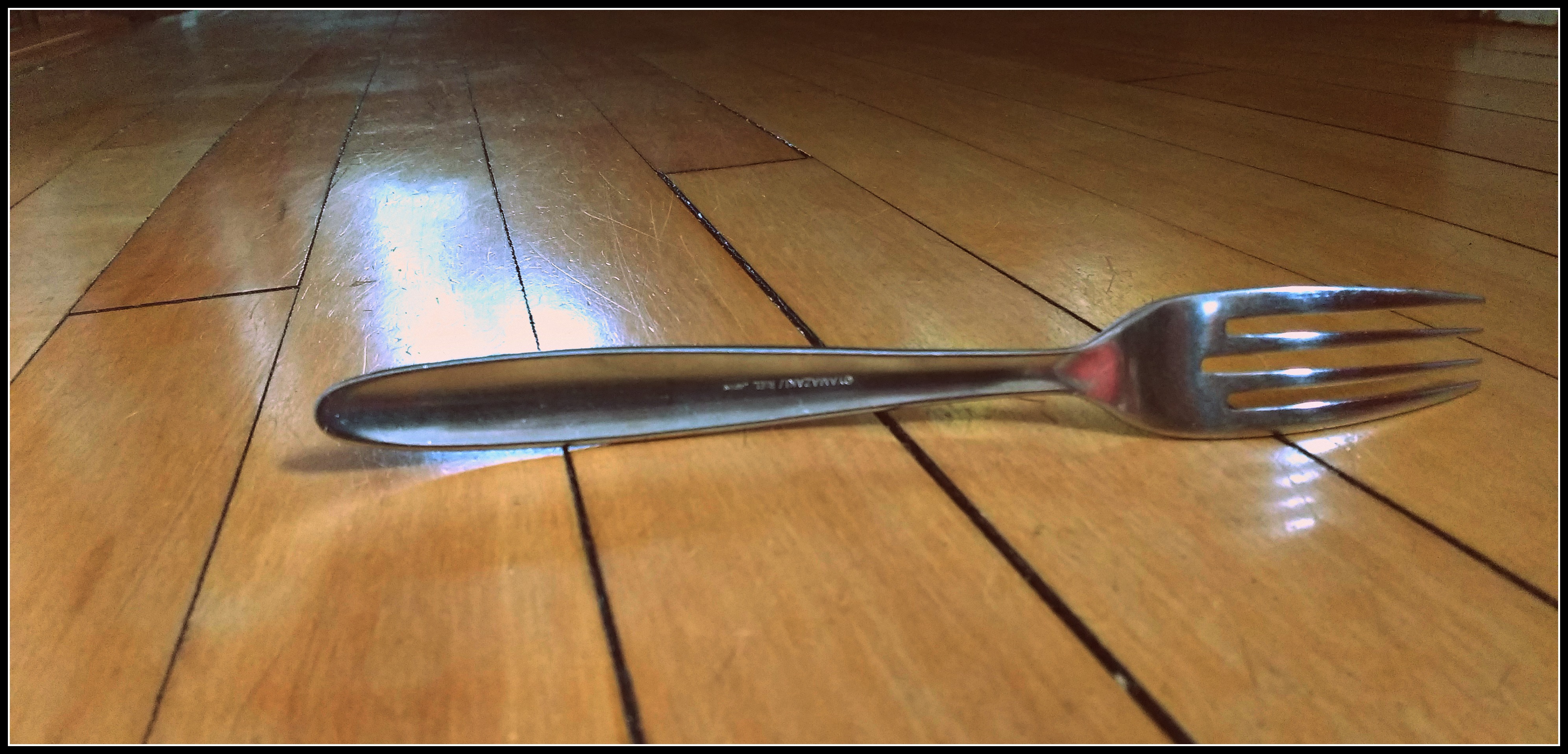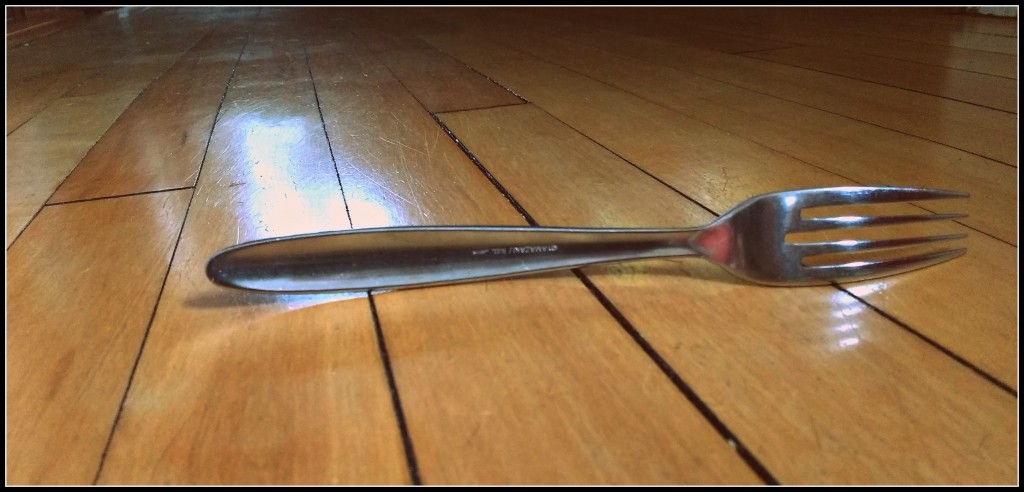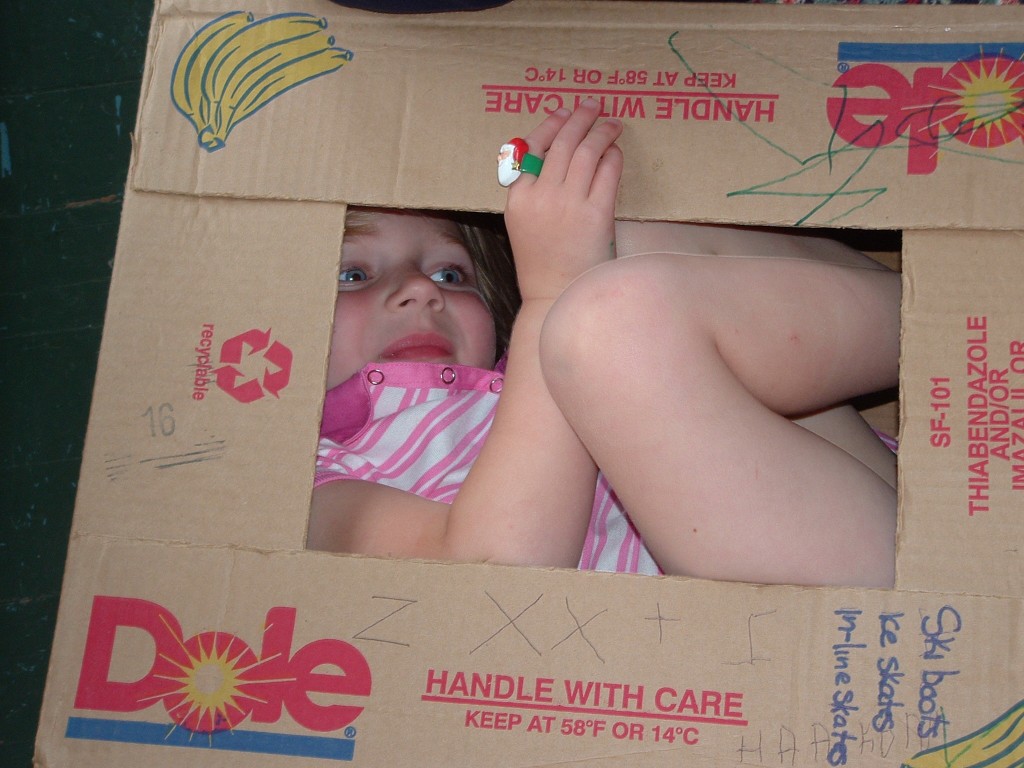Clatterplunk.
Every night we hear it above our heads: the rolling of the office chair as it’s pushed away from the desk, the thump of a plate being grabbed off the wooden desk, and the predictable punctuation of clatterplunk as a fork hits the floor.
These sounds tell us something: the fifteen-year-old is on the move.
Having eaten her dinner in front of the computer, where she’s writing a paper about Julius Caesar or reading a chapter in her e-textbook about the life of a cancer cell or answering questions for APUSH (AP U.S. History), the girl is always ready to take a break after her last bite of stir-fry, taco, or teriyaki chicken. Almost before she’s done chewing, she’s on her feet — collecting her plate and heading down to the kitchen to find a treat. As a matter of course, her silverware hits the floor. Every night.
For some people, after the first few times a fork slipped out of control, a new strategy would be implemented, thus ending the problem. With Allegra, however, the silverware will always win. She tries to control it, but the fork is nimble in a way that she will never be. It’s a body thing, a coordination issue, a fact of her life.
While she’s an excellent runner and skier, there’s no denying it: Allegra can look relaxed and chill while she’s running a half-marathon — as though she’s lounging on a couch, casually surfing the Netflix menu — but do not ask that girl to do a box step unless you delight in seeing stilted lurches wherein right foot is caught under left, the entire torso listing sideways.
Because she’s wired the way she is, she’s able to accept with a shrug the trait some might label as “klutziness.” Her father’s daughter in aerobic ability, endurance, inability to execute choreography, and mild unflappability, she realizes some things just are.
So, every night: clatterplunk.
Then we all have a laugh.
More serious than predictably dropping a fork is what can happen when someone with a floundering mind-body connection gets behind the wheel of a car.
In Minnesota, teenagers can get their driver’s permits when they are 15 and receive their licenses when they are 16. Thus, Allegra spent a bunch of hours last summer taking driver’s education classes, all of which culminated with her passing the permit test.
She’s a very good test-taker, that one. Just don’t ask her to lift her right knee and then her left knee to the thump of a steady beat.
In the months since earning her permit, she’s hacked away at the required behind-the-wheel hours; drivers under age 18 need 50 hours total, with 15 of those completed after dark. Ideally, of course, she will be honing her driving skills in a variety of conditions and with a variety of passengers, as well.
It’s proven surprisingly difficult for her to rack up the hours. She walks to and from school. The extracurricular sports she participates in are based out of the school or, alternately, bus the athletes to a system of trails. After ski practices this winter, we parents would take turns carpooling a few girls, so even on the nights when we were in the car with Allegra some miles from home, it didn’t seem like the right atmosphere — surrounded by two or three giggling peers — to teach her where the hazards light is or how to flick the brights at a passing car. Thus, in the seven months since she received her permit, the majority of the 30 hours she’s accrued have added up in ten-minute increments, when she drives a couple miles on a straight, flat road to and from her job as a dishwasher.
A few times, we’ve taken her out on rambles around town or to the grocery store, but still. She won’t be getting her license ON her 16th birthday, something which, for many teens, is a much-anticipated rite of passage.
That’s okay, though. She’s not ready, and she knows it.
Because commanding a car is a mechanical, spatial venture, a constant choreography that asks the body to move in certain ways and in certain rhythms, driving does not come naturally to our girl. Every time she puts the car into reverse, I half expect a fork to hit the floor.
Regardless of a teen’s aptitude for guiding machinery, of course, the transition from Driver to Passenger is jarring for a parent. At the same time I’m ready for my girl to grow up, ready for her to expand her independence, ready for her to chart new terrain, I can’t forget All of Before.
She used to wrap her entire hands around my pointer fingers; I would hunch over her tiny body, matching her step for step, my bulk shadowing her unsteady toddles. She used to meet me at eye level only when she was dangling upside down from the monkey bars. She used to scream for half an hour after every nap, her pitch shattering wine goblets, because waking up was so hard. She used to beam with pride when, after six eternal minutes of clumsy futzing to snap the buckle between her legs, she finally managed to lodge the clip in the slot and strap herself into her car seat. She used to hang, suspended, three feet above the water line of the swimming pool — on the enchanted plane where preschoolers can fly — after “Daddy phrew me soo high!” She used to tug on my shirt, requesting, “Will you pick me up, so I can see what’s on the high shelves? I want to choose my own snack.” She used to run breathlessly into the room, book in hand, and barrel onto my lap as she pipped, “I can tell myself the story, but I want to know what the actual words say, too.” Astonishingly, she used to fit inside a box.
How, then, can it be that this girl now extends her hand, not for me to hold as we cross the street, but to grab the car keys? How can it be that she climbs behind the wheel while I futz around in the passenger seat with the seat belt, trying to lodge the clip in the slot?
When we’re in the car together, I’m still adjusting to the tipsy role of Mother as Passenger. The point of the exercise is to help my kid develop skills and reactions, to urge her to listen to her intuitions, to help her develop intuitions where none exist. The other point of the exercise is to keep us alive. So I aim for a balance between supportive silence and quiet offerings of “You know, for me, I feel safer if I leave a bit more space between my car and the one in front of it, especially at higher speeds. For you, do you feel like this is enough space for you to stop the car if that truck in front of you slams on its brakes?” Although I’m a teacher by trade, I’m not one for lectures or didacticism. Rather, I feel best with an approach of “What needs to happen here? How are you going to do that, then?”
Occasionally, this approach is accompanied by an audio track: muted gasps and the thunk of my right foot hitting the floorboard.
Mostly, though, with only a couple detours into “With the nose of the car up against this curb you just drove into, your only option is reverse, but since the car is sideways in the middle of the street, be sure you check for traffic before engaging” talk, I kick back and let her figure it out.
A few weeks ago, we were largely silent during what ended up being her most-challenging driving hours. The kids and I had taken a few days to visit friends who live four hours south of us, and Allegra was excited for the chance to add a good chunk of hours to her driving log. Once we were outside congested urban areas, she drove. After four days away, during our trip back home, both darkness and snow fell.
On a scale of Bad Winter Driving Conditions, that evening was maybe a three out of ten. Sure the roads were a bit slippery, there were alarming electronic marquees flashing words of warning to passing traffic, and only one lane was completely clear of snow, but it could have been worse. Reminding Allegra to keep her distance from the car in front of her and to shuck off the pressure of impatient cars behind her, I finished with, “All you can control is this car and your reactions to the behaviors of other drivers. If your gut is telling you to go slower, then go slower. If you don’t want to deal with the snow in the left lane, then don’t pass. Just tuck in behind.”
After that, we lapsed into silence. For several hours, out of the corner of my eye, I watched her hands clench and and tense around the wheel as she dealt with the conditions. A few times, I murmured reassuringly when a huge truck passed us, its force and power rattling us as it coated our car in moisture. Now and then, I noted, “When you hear that rat-rat-rat under the tires? That means you’re driving on the grooves they put outside the highway lanes to let you know you’re veering a bit wide.”
Not once did I think about the clatter of a fork hitting the hardwood. Not once did I worry, “She can hardly spin in a circle on one foot, so how will she handle it if this car starts spinning?” Not a single time did I fret that her inability to catch a ball would kill us.
Driving is a physical activity. It requires communication between the brain and the body. Absolutely. But I realized that night, as we covered the miles in tense silence, that moving solidly throughout the world is ultimately more a mental than physical challenge. It’s one thing to know how to swing the car wide during a left hand turn; it’s another thing entirely to stay focused and keep nerves in check when palms are sweating.
When it comes to steadiness and mettle, Allegra is a teen without peer. The floor next to the wooden desk upstairs may be dramatically dinged by fork tines, but the paint on the car is intact. She can do this.
Any lingering concerns I had about her suitability behind the wheel were quashed that night as we crested the long, major hill that signals the homestretch into our city. As we chugged up the hill, our car was stuck behind a timid driver without snow tires on his vehicle, a guy who was putting along at 40 miles per hour. For a long time, we stayed behind him. Passing was intimidating, given the state of the left hand lane.
After a few minutes, Allegra started to get antsy. She knew she could pass — other cars had been using the left lane successfully — but the thought of leaving the safe comfort of the dry lane made her jittery.
“Hey,” I told her, “it’s fine to just hang behind this guy. If his speed feels right to you, then stick with him. Let him set the pace, and all you have to do is follow him.”
Half agitated, half laughing, the runner-girl protested. “But I don’t want to let him set the pace. I want to set my own pace. I hate having other people in charge of the tempo!” Taking a deep breath, she turned on the blinker and checked her blind spot.
Grinning in the darkness, I relaxed, tipping my head back onto the headrest, letting my eyelids close for a quick second as whole-body maternal gratitude flooded me from the toes up.
I have nothing to worry about.
Smart, composed, determined to set her own pace, this girl — even after she leaves the safe comfort of the dry lane and starts to chug her own way through the world — is going to be just fine.
Her silverware, though?
Not so much.
———————————–




Leave a Reply